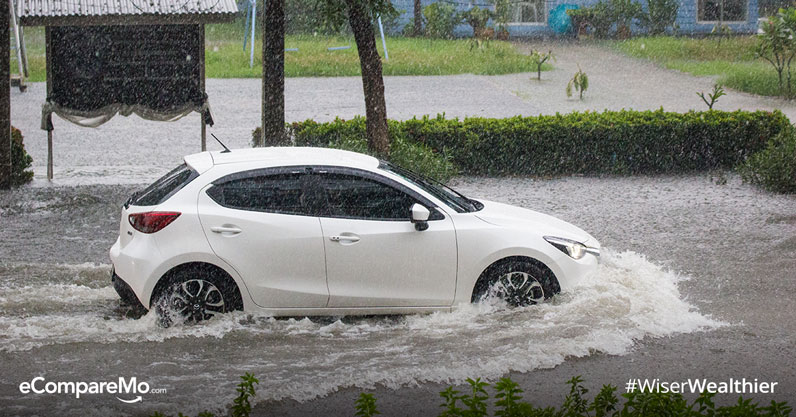Flooded Car Problems: What To Do If Your Car Gets Flooded
4 min read
In 2009, typhoon Ondoy ravaged a huge portion of Metro Manila and surrounding provinces, which left hundreds of lost lives and millions of pesos worth of damaged properties, including flooded cars.
This then gave birth to thousands of vehicles dubbed “Ondoy cars,†or flooded cars that were restored and sold after they’ve been damaged by floodwater.
Fast forward eleven years later, Ulysses has brought upon destruction reminiscent of Ondoy–in the same places no less.
While we believe that there are more pressing matters, we’d like to take this opportunity to offer some much needed public service announcement to car owners who have, at one point or another, experienced their cars getting flooded.
This issue has been making rounds in social media, especially on car enthusiast groups: what to do if one’s car gets flooded—especially concerning repair costs and restoration.
Since it’s typhoon season again, and no one can predict how much water will get dumped at any given day, it is but wise to be ready with a solid plan when your automobile gets submerged in floodwater.
What do you do in case you accidentally drive into knee-deep flood? How do you get out of such a sticky situation? These handy tips just might get your car back running.
Find out how much of your vehicle has been submerged
Sometimes, it is too late for you to move your vehicle to higher ground during the flooding. Risking your life just to save your belongings is a rather foolish idea. In such cases, leave the car and get yourself to a safe place, then make a full assessment of the damage once the flood has subsided.
Look for watermarks as well as the residue of leaves, dried grass, and dirt on the surface of your car—they indicate the flood level and give you an idea of the extent of the damage.
Do not attempt to start the car
It’s tempting to check if your engine is working after it comes in contact with water, but putting the keys in the ignition and starting the car may make things worse (see item No. 4 below). It is best to call your car insurance company to have your vehicle towed to the service center or an accredited repair shop.
Disconnect the battery
Most modern cars are equipped with computer boxes that perform a wide variety of functions, from optimizing engine performance to controlling the transmission, fuel injection, and anti-lock braking system. These computers, of course, rely on the battery for power. To avoid frying your computer box in case it was submerged or has come in contact with water, immediately disconnect the battery from the engine and dispose of it. Sorry, time to get a new one.
Clean contact points for electronic parts
Flooding can cause contact points for your car’s electronic circuits to get encrusted with rust and mud, which means you have to clean them before they get caked. “You’ll need a lot of contact cleaner,†says Big Bert’s Professional Detailers co-owner David Tong. “If the part you’re cleaning is heavily caked with mud, you can use clean distilled water before using contact cleaner to clean and dry out the circuit boards or harnesses.â€
Flush out water from your engine
Oil and water don’t mix well. Water in your engine will make your engine clink since it won’t be able to compress the water. To remove this, you need to disconnect everything from your engine (spark plugs, high-tension cables, fuse, ignition system wiring, etc.) and then drain both the water and oil from the engine. Botchi Santos of the Philippine Daily Inquirer recommends the use of high-quality oil flush chemicals to make the whole procedure smoother. Once you’re sure the engine is completely free from oil and water, put everything back together and refill your engine oil.
Clean out your fuel system
Newer cars have sealed fuel systems, which may make it almost impossible for water to get mixed with the fuel. However, this isn’t the case for older cars, which make them inoperable once flood sets in with the fuel. Mike Allen of Popular Mechanics says siphoning the fuel out of the tank is the best way to check for water content. “Blow out the fuel line, and you may need to get water out of the carburetor float bowls as well,†he advises. “If you find evidence of water in a fuel-injected car or truck’s tank, replace the fuel filter as well.â€
Read:Â Check Out This List Of Flood-Prone Areas In Metro Manila
Dry the interiors ASAP
Water breeds mold, and mold has no place in your precious ride. To avoid creating a breeding ground for fungi in your car’s interior, motoring expert Aaron Gold of About Autos advises that you remove excess moisture by putting towels on the floor to soak up the water, and open windows and doors to let the air in. Eventually, you may have to replace carpets, floor mats, and other fabric material inside the car—otherwise, it will leave a foul smell that’s hard to get rid of.
Remove moisture from your brake and clutch system
Your car’s brakes and clutch system use hydraulic fluid that absorb moisture over time, affecting the performance slowly but surely. “Your brakes will likely fade and you’ll have a big chance of stalling your car in the middle of the flood,†Team Toyota Cebu member Lord Seno shares. “Steering also becomes unresponsive and tires struggle for grip.†Removing the brake and clutch fluid and cleaning their reservoirs of any water will do the trick.
We hope this information could help you ease into the journey of recovery. We wish the best for everyone and our thoughts and prayers are with you always.
Â
